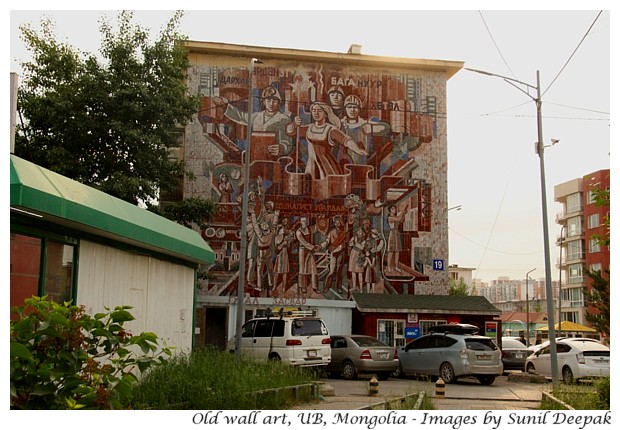This post is about my walk through the city, searching for those camels in Ulaanbataar (UB), the capital of Mongolia.
Mongolia is the land of nomadic people with their animals including horses, sheep, goats and camels – in fact Mongolia has 10 times more animals/cattle compared to its human population. So those camels could have been a representation of a Mongolian nomad. Thus, those sculptures could be a representation of the great Khan or of a Mongolian nomad.
I have been to Mongolia many times for work related to a disability programme. During my first visit to Mongolia in early 1990s, I had stayed in the Bayangol hotel. At that time UB was a completely different city, as Mongolia was just coming out of decades of a communist regime under the Soviet influence. Hardly anyone spoke English, while many persons spoke Russian. There were only a few buildings in this part of UB at that time while the road was narrow and there was no traffic except for a rare car.
This whole area is now completely transformed, full of sky-scrappers. The much wider road is jam-packed with cars. In the nearby Sukhbataar square there is the new parliament building. It is a beautiful place today with wonderful ambience and colourful buildings.
As I started my walk on Embassy road, I saw some beautiful old wall-paintings along the road. Their colours had faded but I could still make out their designs, which seemed to be telling some Buddhist story regarding the killing of some demon. I hope that these can be rennovated.
Mongolian Hero Genghis Khan
Genghis Khan is the national hero of Mongolia. His statues adorn some of the famous landmarks of the country like the central square of UB in front of the national parliament. They can also be seen in some unlikely places like his giant face designed on the side of a hill overlooking the city. Genghis Khan had led his caravans to conquer the world.Mongolia is the land of nomadic people with their animals including horses, sheep, goats and camels – in fact Mongolia has 10 times more animals/cattle compared to its human population. So those camels could have been a representation of a Mongolian nomad. Thus, those sculptures could be a representation of the great Khan or of a Mongolian nomad.
Old wall-paintings & The Motorbike Guy
This time, I am staying at Shangri-La hotel on Embassy road in UB. I came out of the hotel and started my walk by going towards left, to the Children’s Palace, while across the road I could see Bayangol hotel, which is one of the historical hotels of UB.I have been to Mongolia many times for work related to a disability programme. During my first visit to Mongolia in early 1990s, I had stayed in the Bayangol hotel. At that time UB was a completely different city, as Mongolia was just coming out of decades of a communist regime under the Soviet influence. Hardly anyone spoke English, while many persons spoke Russian. There were only a few buildings in this part of UB at that time while the road was narrow and there was no traffic except for a rare car.
This whole area is now completely transformed, full of sky-scrappers. The much wider road is jam-packed with cars. In the nearby Sukhbataar square there is the new parliament building. It is a beautiful place today with wonderful ambience and colourful buildings.
As I started my walk on Embassy road, I saw some beautiful old wall-paintings along the road. Their colours had faded but I could still make out their designs, which seemed to be telling some Buddhist story regarding the killing of some demon. I hope that these can be rennovated.
My first stop was the metallic sculpture of the Motorbike Man, which looks straight out of the Mad Max films, with an alien guy driving an amazing alien looking motorbike. I loved this sculpture placed just outside the Children's Palace. It seems to be the work of an artist called Mr. Santo, born in Thailand, who uses chains, springs, rods, ball bearings, brake bands, gears, and lots of other recycled metal to create art.
Park Place City Marker
I turned left on Chinggis Road (another way of saying Genghis), which is a broad road with never-ending traffic. My next stop was to admire the metallic city-marker of Park Place, showing the distances from UB to major cities of the world, including London, Sydney, Moscow and Beijing.
I have seen similar distance markers in many cities but this was the first time to see a metallic sculpture made for this purpose.
Peace Bridge
Going further south along the Chinggis Road I reached the Peace Bridge which passes above Dund-Gol river and Narnii Road, the bypass road of UB made for avoiding the traffic of the city centre.The Peace Bridge was built with Chinese help in 1963 and was renovated in 2012. Dund-Gol is a small river, which joins Tuul river to the south of UB. From the Peace Bridge, I could see little water in Dund Gol (literally ‘Middle River’). Fortunately, it seemed relatively free of the trash which such places usually seem to get due to neglect.
The Blue Horses and the Summer Fountain
After crossing the bridge I reached the area around the National Sports Stadium of UB, which is full of shopping areas, restaurants and other modern buildings. In front of the square facing the Nadaam Mall, there was an open space with two beautiful blue horses, made in plastic or some synthetic materials. After the Motorbike Man and Park Place City Distances indicator and these horses, I was really impressed by the quality of public art in UB. It was also good to see that local youth had not tried to deface these art works by writing on them, which is a common problem in most urban places.
The fountains next to the horses, erupted with water suddenly and in unpredictable ways. Children playing between those fountains, were having a lot of fun as it was a warm day and many of them were soaking wet. As usually happens in such situations, a couple of adolescent boys had picked another boy and forced-carried him above one of the erupting fountains, accompanied with a lot of shouting and merry-making. Families sitting around looked at them with tolerant bemusement.
Children's Park
Next to the Nadaam Mall is the only pedestrian crossing bridge over Chenggis road. With so much traffic on this road, it was a safe way for me to cross the road. On the other side, the bridge led to a children's park full of statues of zebras, deer, eagles and tigers, where families were children were visiting. It is almost like a zoo, the only difference was that instead of live animals, it has statues.
It also had a nice fountain with the Blue coloured sculpture of a woman wearing traditional Mongolian dress.
Behind the park, I saw an old building which had a mosaic of a Soviet style of wall-art from the pre-1990s period (in the image below). Most of such buildings are slowly being replaced by new constructions. I wish someone would photograph and keep a record of all such wall-arts as these represent the city history.
Genghis Khan Camel Caravan
Finally, I reached the Camel sculptures in the traffic island marking the point where the north-to-south going Chenggis road meets the east-to-west going Chenggis avenue, which goes towards the international airport. The metal sculptures are called the "Silk Road Complex monument" and are the works of an artist called Dalkh-Ochir.
In 2015 a competition was held to identify sculptures for UB and in that competition 15 sculptures were selected. These have been placed in different parts of UB, including the motorbike man mentioned above.
In the Silk Road sculptures, initially there was only one statue of a Bactrian camel. Now there are 9 Bactrian camels, one dog and a bearded man on a horse, who may represent Genghis Khan or perhaps a Mongolian nomad. According to the GoGo website, "Initially the camel monument complex was named Migration and the idea of camels facing towards the city center has a meaning of inflow of wealth."
In 2015 a competition was held to identify sculptures for UB and in that competition 15 sculptures were selected. These have been placed in different parts of UB, including the motorbike man mentioned above.
In the Silk Road sculptures, initially there was only one statue of a Bactrian camel. Now there are 9 Bactrian camels, one dog and a bearded man on a horse, who may represent Genghis Khan or perhaps a Mongolian nomad. According to the GoGo website, "Initially the camel monument complex was named Migration and the idea of camels facing towards the city center has a meaning of inflow of wealth."
I am glad that I had decided to make this walk to look for those camels. They looked absolutely amazing. The sculptures are huge and made with a metallic sheet, and thus can hopefully withstand the harsh Mongolian winter.
I spent some time walking around the sculptures and clicking pictures while the amused locals, waiting for the bus at the bus-stand across the road looked at me.
It was a very satisfying walk. It took me a couple of hours, but that was because I was stopping every where to look around and click pictures. If you are in a hurry, you can do it faster. The image below shows another Soviet-era wall-art from a building near the Silk Road complex crossing. I am fascinated by the history hidden in these wall-arts.
I spent some time walking around the sculptures and clicking pictures while the amused locals, waiting for the bus at the bus-stand across the road looked at me.
To Conclude
Just after the Silk Road monument complex crossing, there was the Palace and Museum of Bogd Khan, who was the first king of Mongolia after its independence from China in early twentieth century. However, I was too tired by this time and decided to leave visiting that to another day.It was a very satisfying walk. It took me a couple of hours, but that was because I was stopping every where to look around and click pictures. If you are in a hurry, you can do it faster. The image below shows another Soviet-era wall-art from a building near the Silk Road complex crossing. I am fascinated by the history hidden in these wall-arts.
UB has some wonderful examples of good quality public art. Though I have been to UB many times, I am not much acquainted with the town except for the area around Gandam monastery. I am glad that this time I could explore a new part of the city.
*****
#mongoliaub #ubmongolia #ulaanbaatar #publicart #genghiskhan



















